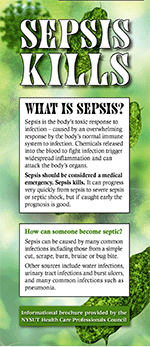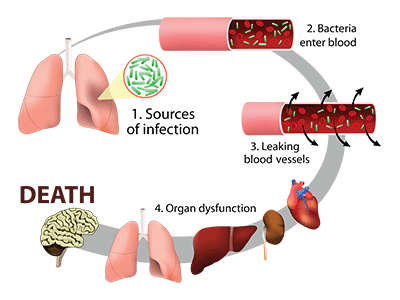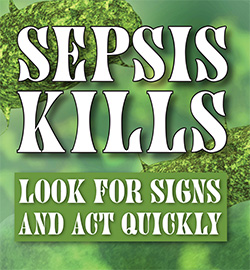"Sepsis - which is sometimes called blood poisoning - is a serious, toxic response to infection by the body's normal immune system," says NYSUT Vice President Paul Pecorale in this new video. "Early recognition and treatment is the key to saving lives."
The numbers are staggering: sepsis kills far more people than prostate cancer, breast cancer and AIDS combined, yet only 44% of U.S. adults have heard of sepsis. It can progress very quickly from sepsis to severe sepsis or septic shock - but if caught early the prognosis is good.
In 2015, after father and foundation founder Ciaron Staunton spoke to professionals at the annual NYSUT Health Care Forum about the true cost of sepsis -- human lives -- NYSUT took action. The United Federation of Teachers brought a resolution to the union's spring Representative Assembly, where delegates voted in support of sepsis awareness and education. The resolution states, in part, that young children and the elderly experience the greatest number of sepsis-related death. Sepsis can be prevented with early detection and treatment, so NYSUT supports a nurse in every school building to educate parents and students to the signs and symptoms of infection when a child is exposed to injury. NYSUT will promote sepsis awareness and educations in schools, hospitals, home care and communities, with NYSUT professionals working in each of those fields. NYSUT supports legislation urging the Center for Disease Control and the U.S. Department of Health and Human Services to provide educational information and awareness, in addition to establishing early detection protocols across the country.
NYSUT's Health Care Professionals Council is committed to raising awareness about sepsis. Check out the resources below!
Get informed, spread the word - and help save lives!
By Liza Frenette. NYSUT United. May 22, 2015.
 When 12-year-old Queens student Rory Staunton scraped his elbow playing basketball, the wound received only a Band-Aid. It wasn't cleaned or treated with antibiotic cream. Nor was Rory sent to the school nurse. Strep A had been going around in the school, yet his parents had not been notified. Rory developed a high fever and was brought to a New York City hospital. He was sent home, despite having symptoms of sepsis - blood poisoning - something his parents had never heard of. Three days later Rory was back at the hospital, where he died in the ICU. The painful journey of Orlaith and Ciaran Staunton, Rory's parents, takes them far and wide to remedy ignorance about sepsis.
When 12-year-old Queens student Rory Staunton scraped his elbow playing basketball, the wound received only a Band-Aid. It wasn't cleaned or treated with antibiotic cream. Nor was Rory sent to the school nurse. Strep A had been going around in the school, yet his parents had not been notified. Rory developed a high fever and was brought to a New York City hospital. He was sent home, despite having symptoms of sepsis - blood poisoning - something his parents had never heard of. Three days later Rory was back at the hospital, where he died in the ICU. The painful journey of Orlaith and Ciaran Staunton, Rory's parents, takes them far and wide to remedy ignorance about sepsis.
READ THE FULL STORY.
Frequently Asked Questions
 What is sepsis?
What is sepsis?
Sepsis is the body's toxic response to infection - caused by an overwhelming response by the body's normal immune system to infection. Chemicals released into the blood to fight infection trigger widespread inflammation and can attack the body's organs.
Sepsis should be considered a medical emergency. Sepsis kills. It can progress very quickly from sepsis to severe sepsis or septic shock, but if caught early the prognosis is good.
Awareness
Sepsis kills far more people than prostate cancer, breast cancer and AIDS combined, yet only 44% of U.S. adults have heard of sepsis.
Despite various campaigns and the availability of good evidence for treatment, the death rate associated with sepsis remains high, mainly due to poor identification and delayed interventions.
The very old, the very young and those with compromised immune systems can be at higher risk.
How can someone become septic?
Sepsis can be caused by many common infections including those from a simple cut, scrape, burn, bruise or bug bite. Other sources include water infections, urinary tract infections and burst ulcers, and many common infections such as pneumonia.
What are the symptoms of sepsis?
To be diagnosed with sepsis, you must exhibit at least two of the following symptoms:
- Fever, chills
- Rapid or difficult breathing
- Elevated heart rate
- New confusion, disorientation or drowsiness
- Severe muscle and joint pains
- Skin Rash
- Poor feeding (infants and children)
Many of these symptoms, such as fever and difficulty breathing, are the same as in other conditions, making sepsis hard to diagnose in its early stages.
Severe sepsis
The following signs and symptoms, indicate an organ may be failing:
- Abrupt change in mental status
- Significantly decreased urine output
- Decrease in platelet count
- Difficulty breathing
- Abnormal heart pumping function
- Abdominal pain Septic shock
Severe sepsis, plus extremely low blood pressure that does not adequately respond to simple fluid replacement, indicates that the patient may be in septic shock.
For severe sepsis or septic shock, lifesaving measures may be needed to stabilize breathing and heart function. Sepsis should be treated as a medical emergency - as quickly and efficiently as possible with rapid administration of antibiotics and fluids. People with sepsis are usually treated in hospital intensive care units.
Doctors try to treat the infection, sustain the vital organs and prevent a drop in blood pressure by prescribing medications and treatments including intravenous (IV) fluids to maintain normal blood oxygen levels and blood pressure. Antibiotics alone will not treat sepsis. Ensuring the body has enough fluids helps organs function and may reduce damage from sepsis.

What can be done in schools?
Early recognition and early treatment is the key to saving lives. Ensuring that a school nurse is on staff in every school to educate parents and students to signs and symptoms of infection when a child is exposed to injury and potentially life-threatening bacteria is crucial.
School nurses play a vital role in spotting sepsis. They are critical to identifying patients who are unwell or deteriorating, and in initiating life-saving treatments.
Can hospitals reduce the numbers of severe sepsis they treat?
Yes. It is crucial for medical staff to identify patients with sepsis on the floors and in the Emergency Department before they progress to the severe stage.
Economic Cost: Sepsis is the most expensive condition treated in U.S. hospitals, costing more than $20 billion in 2011, increasing on average by 11.9% annually.
Why is sepsis so dangerous?
- More than 1.6 million people are hospitalized in the U.S. each year — one every 20 seconds.
- Sepsis contributes to about 40% (258,000 deaths) of U.S. hospital deaths each year (approximately 550 people every day) — far more than the number of U.S. deaths from prostate cancer, breast cancer and AIDS combined.
- Many patients already have sepsis upon admission to a hospital.
- Mortality increases 8% every hour treatment is delayed.
- Sepsis is the leading pediatric killer worldwide.
- Sepsis affects more than 26 million people worldwide each year.
